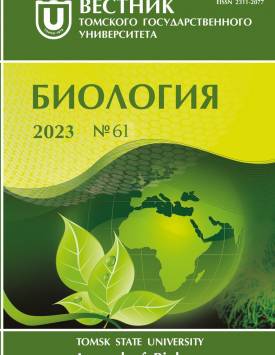Breeding biology of the Western Siberian Great Tit population in urban and natural habitats over a 30-year period
The study summarizes the results of thirty years of observations of the breeding biology of the Western Siberian population of the great tit (Parus major), one of the few model bird species that can be studied throughout the annual cycle of individuals. Identification of population and biotopic features in the reproductive behavior of birds is an important task in studying the lifestyle of individuals and adaptations of the species to environmental conditions and to the conditions of altered habitat. Therefore, the aim of this work is to study different aspects of the breeding biology of great tits in urban and natural habitats. In Siberia, urban areas are of key importance for the great tit, where birds successfully winter at high densities and move to the surrounding forest habitats for nesting [1-3]. As a result, individuals in this population become more sedentary, more faithful to wintering and nesting sites, as well as to their mating partner, and the range of migratory movements is reduced for the birds [3-5]. Nesting becomes monocyclic for most individuals in the population [3, 6]. In the studied population, the nesting period extends over 84 days, from April 21 to July 14. Single nesting (monocyclicity) is characteristic of most individuals in the population, which is observed in the structure of different types of clutches (See Fig 1). The proportion of first clutches is 81.3%, and the proportion of repeat clutches is 11.4%. Compensatory (1.3%) and second (6.0%) clutches were not detected every year (See Fig. 11). The timing of the first clutches in the forest (3 May) and in urban areas (5 May) and the length of the total nesting period (2.5 months) did not differ between these habitats. However, average clutch initiation date in urban areas during the period of observations shifted by 6 days from 10 May to 4 May (See Table 2). The fecundity of individuals was significantly higher in natural habitats (12.1 eggs; 11.8 nestlings; 10.3 fledglings) compared with urban habitats (10.4 eggs; 9.7 nestlings; 7.0 fledglings) (see Table 2, Fig. 2, 7, and 9). The second breeding cycle was three times more common in the forest (14.5%) than in the city (5.1%). The fecundity of individuals in the second nesting cycle in different habitats differed only in the number of fledglings. The average number of fledglings was higher in the forest (6.83 ± 0.54) than in the city (5.38 ± 0.40; p = 0.043). Fecundity in the second nesting cycle (7.2 eggs, 6.6 nestlings, and 5.8 fledglings, mean for both habitats) could have increased only by 2.6% in the city and 7.7% in the forest (measured as number of fledgling). The incubation periods of different females can vary from 11 to 23 days (mode 14, mean 15.2 days) (See Fig. 3). The mean incubation time of first clutches varied between years by 4.5 days (range 13.2 to 17.7 days) (See Fig. 5). The first clutch incubation period was particularly shortened (by two days; See Fig. 4). Longer incubation periods had no effect on hatching success, but longer incubation periods negatively correlated (Rs = -0.20) with rearing success, decreasing it by an average of 11.5% (p = 0.007). This negative correlation between extended incubation time and rearing success was observed in broods independent of their sizes (See Fig. 6). The nestling feeding period lasted from 16 to 21 days (in 1 case, 23 days). The average length of time nestlings stayed in the nest was 18.04 ± 0.42 days (n = 22). Taking into account the interannual variability in the proportion of first clutches with 100% nesting success in urban areas (See Fig. 8), the proportion of nests with 100% nesting success in urban and natural habitats (See Fig. 10), and the involvement of birds in the second nesting cycle (See Fig. 11), we concluded that factors such as food abundance and weather conditions were the most important determinants of reproductive success in this population of great tits. The combined effect of these factors on individual breeding success appears to be the primary driver differences of great tit breeding success in urban and natural habitats. The paper contains 12 Figures, 2 Tablse, and 25 References. The Authors declare no conflict of interest.
Keywords
Parus major, nesting success, incubation duration, nesting cycle, natural habitats, urban environmentAuthors
| Name | Organization | |
| Gashkov Sergey I. | Tomsk State University | parusmajorl@rambler.ru |
| Grinkov Vladimir G. | Lomonosov Moscow State University; Tomsk State University | v.grinkov@gmail.com |
References

Breeding biology of the Western Siberian Great Tit population in urban and natural habitats over a 30-year period | Vestnik Tomskogo gosudarstvennogo universiteta. Biologiya - Tomsk State University Journal of Biology. 2023. № 61. DOI: 10.17223/19988591/61/4
